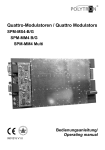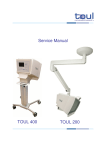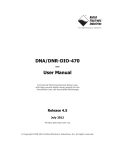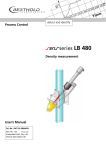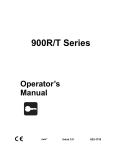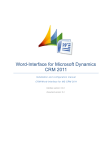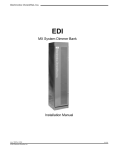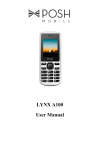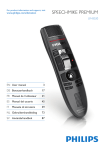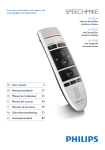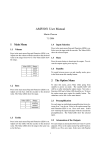Download Twinkle - Phenix Research Products
Transcript
Instrument Manual Twinkle™ LB 970T Fluorometer Valid for instruments with software version 2.xx BERTHOLD TECHNOLOGIES GmbH & Co.KG Calmbacher Str.22 D-75323 Bad Wildbad, Germany www.BertholdTech.com 2 Contents 1. Safety Information and Warnings 3 Safety Instructions for Service Special Spare Parts 4 4 2. Functional Description 5 Fluorescence (Top Counting) Fluorescence (Bottom Counting) 5 7 3. Installation Instructions 10 4. Instrument Installation 11 Environment Electric Power Connection to other units 13 13 14 5. Information about User Instructions 15 Instrument- and User Manual On-line Help Routine maintenance 15 15 15 6. Software Installation 15 Minimum System Requirements Printer Installation Installation of the Workstation software on a portable computer Setup 7. Routine Maintenance 15 15 15 16 19 Cleaning the instrument Changing the CW- Lamp Compacting the database 19 19 19 8. Specifications 20 3 1. Safety Information, Warnings and Special Spare Parts Caution! - This symbol alerts you to important operating considerations or a potential operating condition that could damage equipment. Refer to the User`s Manual or Instrument`s Manual for precautionary instructions. General: • This equipment must be installed and used in accordance with the manufacturer’s recommendations. Installation must be performed by properly trained and authorised personnel. • This fluorometer is equipped with a three-wire grounded plug, a plug with a third (grounding) pin • This a safety feature. If your outlet does not accomodate the three wire-plug, have an electrician install the correct outlet, or use an adapter to ground the appliance safely. Do not defeat the safety purpose of the grounded plug. • These instructions contain important operating and safety information. The user must carefully read and understand these instructions before using the instrument. • Failure to follow these instructions may invalidate your warranty and/or the safe functioning of your equipment. • The instrument has been designed to optimise function, reliability, safety and ease of use. It is the user’s responsibility to install the instrument in conformance with the local electrical codes. • To disconnect the instrument from power the appliance coupler must be removed from the mains. • Put the instrument in such a position that it is easy to switch on / off. • Remove the transport protection before switching on the instrument. 4 • Don’t block the ventilator while the instrument is running. • The LB970T may be transported only in its proper transportation package. • For cleaning of the instrument read point 7 ( Routine Maintenance ) in this manual. • Additionally read the notes in the User Manual on page 20, 28 and 56. • Since chemical substances are being used when operating the instrument, the manufacturer’s warning and safety precautions ( R and S sets ) have to be observed. To avoid personal injury : • The interior of the instrument can reach temperatures that can cause burns. Avoid contact with the heating plates. Some parts of the instrument can remain hot without visual indication for some time after the power is turned off. • The metal part over the lamp can be hot. Don’t start the instrument without the plastic cover over the lamp ! • Don’t use a flammable liquid inside the instrument. A fire hazard may result. • Don’t open the flap while the instrument is running. Safety instruction for service • Disconnect the instrument from the main power prior to maintenance and servicing. • When the top part of the housing is removed, no safety measures are in effect. Be careful if the instrument is running. • When the top part of the housing is removed, take care with any moving parts. • High voltage is generated in the multiplier unit. Don’t touch the unit while the instrument is running. • Proper operation is ensured only when using original spare parts. Special Spare Parts The following spare parts are safety parts. Use always the original part from the manufacturer or direct agent. Fuse : 2.00A/T 5x20 UL 1986 / CSA C22.2 Id. No.: 09892 Power Supply : JWS-150-24/A, 100-240VAC,24V/6.5A ( Lambda ) Id. No.: 34846 Power Entry Modul w. Switch : KD14.1101.151( Schurter ) Id. No.: 34036 5 Heating Plate : 24V/40W Halogen Photo Optic Lamp : ( Horn ) 12V/75W Typ 64613 ( Tungsten ) 6 Id. No.: 34846 Id. No.: 34051 2. Functional description Fluorescence (Top Counting) Inside the fluorometer there is a tungsten-halogen continuous wave lamp (75 W). This is used as the light source for fluorescence measurements. The lamp unit is thermally isolated from the measuring head by using a light-guide to channel the light to the sample. The actual wavelength used is selected by means of a slide containing up to 5 filters. The filter to be used can be selected by means of the software. The spectral range of the Excitation module is 340 - 700 nm. Two positions of the standard 5-position excitation filter slide are used for filters of 355 and 485 nm, which are specially designed for fluorescence excitation. All standard filters are high quality interference filters with a diameter of 15 mm for Excitation filters and 25 mm for Emission filters. There are three empty filter positions into which customized filters can be inserted. See the figure. 7 Light of the selected wavelength having passed through the light guide is collimated through the sample. The stabilised excitation energy is user-adjustable to help find the optimum linear range for the samples being measured and thus keep the output signal within the linear range of the instrument. Fluorescence is collimated from the plate through a mirror slide, a lens system and an 4-position emission filter slide to a low noise photomultiplier (spectral range 400 - 700 nm) equipped with fast single photon counting electronics. In the emission filter slide two positions are used for emission filters of conventional fluorescence at wavelengths of 460 and 535 nm. Note: when the properties of a label are defined, then the filters to be used for measurements with that label are specified. When a protocol is selected for a measurement, the appropriate filters are moved into position automatically. Both excitation and emission light are directed and collected from the top of the well. See the next section for information on bottom counting. 8 Fluorescence (bottom counting) In the case of bottom counting of prompt fluororescence samples, excitation light is directed through a light guide underneath the plate. Emission light goes back along the same light guide to the optical block and passes through the emission filter to the PMT. Bottom counting means that measurements can be made for samples in which cells are at the bottom of the wells or there are lids on wells. Switching between top and bottom counting is done by software and both methods can be used for the same plate. Kinetic measurements To investigate the kinetics of a reaction, repeat measurements are necessary. The number of repeats (up to 100) can be specified and the time between repeats, up to 600 s. These fast kinetic measurements can only be made if "well mode" is selected. Slow kinetic measurements can also be made using plate repeats. Scan measurements Measurements can be made at different points of a well for samples in which the light output is not homogeneous, e.g. in cell culture wells. The number of spots to be measured can be defined. Up to ten spots can be measured in both the horizontal and vertical directions (maximum of 100 points altogether). The distance between spots can be set. The distribution of the measurement spots can be square or circular. 9 3. Installation Instructions Unpacking Open the box and remove the packing. Lift the instrument up and move it to its place of operation. Check the fluorometer for possible transport damage. Remove the transport protection piece as follows : Pull on the red tab sticking out from the plate loading position. 10 The plate holder will come out revealing the transport protection piece. Undo the two black screws holding the transport protection piece in place. 11 Remove the transport protection piece. Remove the protection piece from the filter 1 opening. The instrument is now ready to be used. 12 4. Instrument Installation Environment Although normal clean laboratory conditions are usually satisfactory as an operational environment it is useful to take the following points into consideration. The temperature should be in a range of 25°C to 35°C, the relative humidity should not be excessive and direct sunlight should not be able to reach the instrument. Electric Power Three electrical outlets each with a protective earth should be available, with., if possible, a separate power line for the instrument itself having an isolation switch and a fuse box. If excessive fluctuations in the mains voltage are anticipated, a main stabilizer may be necessary. The main switch, appliance coupler and the main fuse is on the backside of the instrument. Important : Please read the Safety Information and Warnings before you start the instrument! Put the instrument in such a position that you will always have a good access to the main switch and the appliance coupler. Connection to other units 13 This fluorometer is a compact bench top unit designed for measuring prompt fluorescence by top or bottom counting. The software is a 32-bit application running under Windows 95, Windows 98/ Windows NT 4.0 or Windows 2000 on a PC connected to the instrument. Results are saved in a file format for further connection to a laboratory information system. Plates are loaded manually. Read under point 7 ( Routine Maintenance ) Compacting the database. The figure below shows the fluorometer with a PC and a printer. Connection Connect the fluorometer to the serial port of the PC using the zero modem cable provided. Use the power cable to connect the fluorometer to the mains. Switch on the PC and the fluorometer. 5. Information about User Instructions 14 Instrument- and User Manual There are two manuals that come with the fluorometer. This Instrument Manual is for the hardware installations and the User Manual for more detailed information necessary for operating the fluorometer. The Instrument Manual is normally not needed by the normal user, only by the engineer who installs the fluorometer. However you might need it if you have to reinstall the system in another location in the future. On-line Help This is supplied with the software and can be accessed by clicking Help in any window. This “Help” gives detailed information about all features of the operation which concern the normal user ( service information is not provided ). There is a table of contents giving an overview of the Help, including a “How to” section, a topic index in alphabetical order, as well as a search facility enabling any word in the help to be located. Topics are connected where relevant by hypertext links so that you can easily find all information on a particular subject. Routine maintenance This is maintenance intended to be performed by the user and is described in a separate chapter of this instrument manual. Any other maintenance than what is described there should be performed by a qualified service person. 6. Software Installation Minimum System Requirements • • • • • • Windows 95/Windows 98/Windows NT 4.0/Windows 2000 Intel Pentium Processor 16 MB RAM (or more) 30 MB free hard disk space (or more) CD-ROM Drive Super VGA Drive (minimum setting is 800 by 600 pixels) Printer Installation Install the printer according to the instructions accompanying the printer. 15 Installation of the Workstation software on a portable computer General For installing the Workstation on a portable computer, connect the instrument to the free COM port of your computer using the standard zero modem cable. Windows NT When installing and running the software under Windows NT/Windows 2000, the user MUST belong to the local Administrators group. This because the security system of Windows NT otherwise prevents the correct installation or operation of the software. To add a user to the local Administrators group, do the following: Note: This must be done by a user already belonging to the local Administrators group! 1. Start the User Manager program found under Administrative Tools. 2. Double-click on the username to add to the local Adminstrators group. 3. Click the Groups button. 4. Add the 'Administrators' group to the 'Member of:' listing. 5. Click OK. 6. Click OK in the User Properties window. 7. Exit the User Manager program. 8. Proceed as in Windows 95 Windows 95 Workstation Installation to a PC connected to the Net If the installation is made with a certain user logged into the PC, a problem occurs when another user tries to run the workstation. This is because during the installation some of the registry files written to the hard disk will be accessible only for the one that was logged in during the installation. To overcome this problem there are three different possibilities: Install the workstation with the PC disconnected from the net This is not the best possible way to do it since, depending on how the net is constructed, there might still be problems with the registry files for the different users. Also the icons for starting the workstation might be missing. Make a separate installation for each user Install the workstation for each user separately logged into the PC. All the necessary files and icons will be accessible for each one. If there are many users this is time consuming. Make a separate user name for the fluorometer users The local net support person creates a single user name and password specially for the fluorometer users. The installation is then done when logged in as this user. 16 Setup Exit all Windows programs and insert the CD-ROM into the PC; the setup will start automatically. Note: If the setup does not start automatically, it is probably because the Auto insert notification for the CD-ROM drive is not activated. Run the setup.exe on the CD or activate the auto insert notification in the following way: My computer->Control panel->System-> Device Manager->Double Click CD-ROM->Double Click CD-ROM Drive->Settings-> Select Auto insert notification->OK->OK-> Yes for rebooting the PC for the change to take effect. The following pop-up menus will appear when the setup is started. Read the menus carefully and follow the instructions (for first time installations the default values should be used). Click on Next. 17 For first time installation click on Next. (Note: When updating the software, acitvate the database for update via custom settings) Click Next (with no instrument, the workstation can be run in demo mode and the software itself simulates the instrument). 18 If all settings are OK, installation is finished. 19 7. Routine Maintenance Cleaning the instrument The plate carrier surface should be kept clean to avoid dust and dirt entering the optics at the measuring position. The plate carrier should be cleaned at least once a week using a soft cloth or tissue paper soaked in a mild detergent solution or alcohol. Changing the CW- Lamp If the CW- Lamp needs replacing, switch off the power and pull off the cover on the right side of the fluorometer to get access to the lamp. Unscrew the panel holding the lamp and withdraw it through the hole in the body of the fluorometer. Attention : The metal panel over the lamp and the lamp itself can be hot ! Make sure the lamp is switched off and give the lamp a chance to cool before removing it. Do not touch the lamp, since you might damage it ! Remove the lamp from its mounting and insert a new one. Put the lamp and its mounting back into the instrument and screw it back in place. Replace the cover, then switch on the power. Compacting the database You should run the Database Maintenance program on a regular basis ( weekly or monthly depending how much you work with the fluorometer). This program will compact your database and will in some situations increase the software performance. If you ignore that, the access time will increase. You can find the program by clicking on the icon in your Window Start menu. It is called “Database Maintenance”. 20 8. Specifications Power requirements Power consumption: Nominal voltage: Nominal frequency: Input voltage range: 180 VA 100-240 V, multirange. 50/60 Hz 85 - 264 V, 47/63 Hz Safety standards 1. EN61010-1:1993 or IEC 1010-1:1990 + A1, modified (Safety requirements for equipment for measurement, control and laboratory use). 2. EMC- Directive (immunity and emission ) EN 61326-1:1997/A1:19998 EN61000-3-2:1995/A1:1998 EN61000-3-3:1995 Environmental conditions Temperature 15 - 35°C Relative humidity 10 - 85 %. Excitation Tungsten-halogen lamp, 75W, lifetime typically > 300h, Spectral range 340 - 700 nm. Filter slides 1. Excitation filter slide with 5 filter positions. Comes with high quality interference filters for excitation, centre wavelength (bandwidth) 355 (30) nm and 485 (15) nm. 2. Emission filter slide provided with 4 filter positions with the following filters: centre wavelength (bandwidth) 460 (30) and 535 (30) nm. Detector State of the art low noise/high sensitivity photon counting system, sensitive in the range of 300 to 650 nm. Plates 1 to 864-well plates are compatible with the instrument. The user can define non-standard plate configurations. The maximum outer dimensions are 86.0 x 128.2 x 25 mm. Scanning Scanning of wells (several measuring points within a well) is available. 21 Repeats Repeated measurements or operations can be defined by plate, strip or well. Measurement time Detection time per well is software selectable between 0.1 - 600 seconds. Performance Fluorescein detection limit is < 10 fmol / well Physical dimensions Weight Height Width Depth 17 kg 280 mm 465 mm 406 mm Software The instrument program is run under Windows 95, Windows 98 or Windows NT 4.0 on a Pentium computer, minimum 16 MB memory, equipped with a CD-ROM, super VGA display minimum resolution 800 x 600 pixels and 256 colours. Input/Output connections Connection to PC via serial RS 232 interface by standard 9-pin cable (zero modem cable). The printer is connected to the parallel port of the PC. Counting modes Top fluorescence (340 – 650 nm) Bottom fluorescence Scanning Fast or slow kinetic measurements 22























